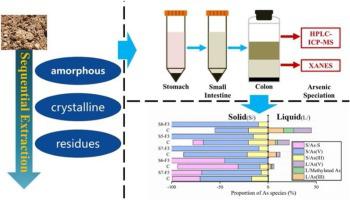Journal of Hazardous Materials ( IF 12.2 ) Pub Date : 2020-07-03 , DOI: 10.1016/j.jhazmat.2020.123366 Naiyi Yin 1 , Yunpeng Li 1 , Xiaolin Cai 1 , Huili Du 1 , Pengfei Wang 1 , Zeliang Han 2 , Guoxin Sun 3 , Yanshan Cui 1

|
Soil arsenic (As) fractionation and its bioaccessibility are two important factors in human health risk assessment. However, data related to the impact of As minerals on the bioaccessibility with human gut microbiota involvement are scarce. In this study, speciation analysis was determined using HPLC-ICP-MS and XANES after incubation with colon microbiota from human origin, in combination with sequential extraction. Significant increase of colon As bioaccessibility was contributed primarily from As associated with amorphous and crystalline Fe/Al (hydr)oxides. We found a high degree of transformation at higher bioaccessibility (ave. 40 % of total As), which was predominantly present as liquid-phase As. In contrast, As transformation occurred mainly in the solid phase at lower bioaccessibility (< 5%), especially for soils containing As-S species. XANES spectroscopy revealed that As(III) increased by about 20 % in soil residues. Finally, the excreted As may be predominantly in association with (alumino)silicate minerals by SEM-EDX. It inferred that the priority sequence in As transformation by human gut microbiota was dissolved As(V), As(V) sorbed to mineral surfaces, crystalline As(V)-bearing minerals and As sulfides. This study will shed new light on the role of As-bearing minerals in evaluating health risks from soil As exposure.
中文翻译:

在人类肠道菌群的存在下,土壤砷分馏在砷的生物可及性,转化和归宿中的作用。
土壤砷(As)的分离及其生物可及性是人类健康风险评估中的两个重要因素。但是,与砷矿物对人体肠道菌群参与的生物可及性影响的数据很少。在这项研究中,在与人类起源的结肠菌群孵育后,结合顺序提取,使用HPLC-ICP-MS和XANES测定了形态分析。结肠As生物可及性的显着增加主要是由于As与无定形和结晶的Fe / Al(氢)氧化物有关。我们发现在较高的生物可及性(占总砷的40%)下发生了高度转化,这种转化主要以液相砷形式存在。相反,砷转化主要发生在固相中,生物可及性较低(<5%),特别是对于含有As-S物种的土壤。XANES光谱显示,土壤残留物中的As(III)增加了约20%。最后,通过SEM-EDX,排泄的砷可能主要与(铝)硅酸盐矿物结合。推断人类肠道菌群进行As转化的优先顺序是溶解As(V),As(V)吸附到矿物表面,结晶的As(V)矿物和As硫化物。这项研究将为含砷矿物在评估土壤砷暴露对健康的危害方面的作用提供新的思路。晶体中含有As(V)的矿物和As硫化物。这项研究将为含砷矿物在评估土壤砷暴露对健康的危害方面的作用提供新的思路。晶体中含有As(V)的矿物和As硫化物。这项研究将为含砷矿物在评估土壤砷暴露对健康的危害方面的作用提供新的思路。











































 京公网安备 11010802027423号
京公网安备 11010802027423号